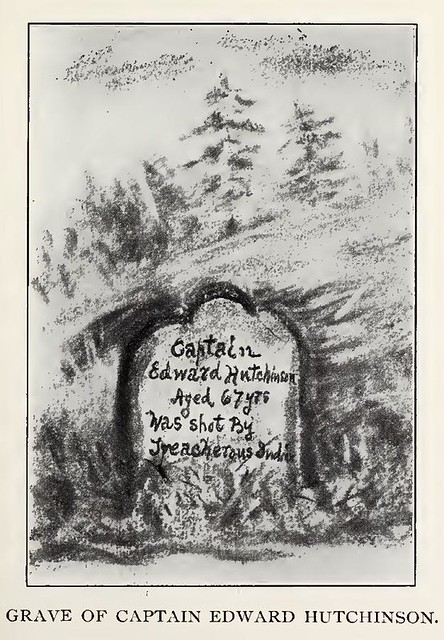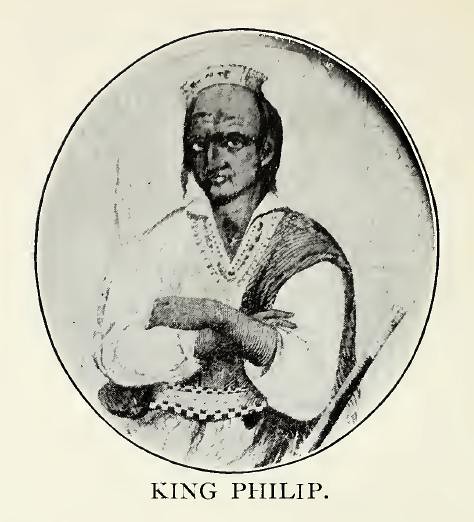A public domain selection from Historical
Reminiscences of the Early Times in Marlborough, Massachusetts by Ella. A. Bigelow
(1910), pp. 96-99:
Those
interested in quaint epitaphs will be rewarded by a visit to this place. The
question has often been asked where were the Marlboro people buried previous to
1675, the date on the burial stone in the above cemetery of Capt. Hutchinson.
The theory is that up to the latter date the people of Marlboro feeling their
tenure of territory insecure, the earlier burials doubtless were all made in
the older grave yards of Wayland, Watertown or Charlestown. If possibly any
were unable to travel thither, every greatest effort must have been made to
secretly bury the dead and hide all traces from the inhuman and sacriligious
foe. The custom of burying the dead in the homestead grounds originated no
doubt at this time of dread, and probably was the reason for the loss of many
early records. The fact of the church being located upon the Indian planting
field would be an argument against the burying the dead so near to the foe, and
altho' the yard adjoining the old Common
(back of High School) may have been the oldest in name, Spring Hill Cemetery
near the Union Church contains the remains of most of the earlier settlers
since 1675 and may surely be considered the oldest burying ground in the town.
Nearly in the center of the yard is the oldest stone located.
"Capt.
Edward Hutchinson aged 67 years was shot by Treacherous Indians Aug. 2, 1675.
Died August 19, 1675."
Capt.
Hutchinson of Boston was wounded in Brookfield and unable to get any farther on
his way home than the public house kept by John or as he was usually called
Goodman Howe, where he died Aug. 19th, and was the first person buried in the
above old burying ground. His headstone is still standing and the inscription
on it still legible.
KING PHILIP.
"Away! Away! I will not hear
Of aught but
death or vengeance now.
By the eternal skies I swear
My knee shall
never learn to bow!
I will not hear a word of peace
Nor clasp in
friendly grasp a hand
Link'd to the pale-brow'd stranger race
That work the
ruin of our land."
The most eventful period in the history of Marlborough
is that connected with the Narraganset or "King Philip War." When the
people from Sudbury petitioned for a grant of land eight miles west, and after
the punishment of the Pequots in 1638, and their submission to the colony agreeing
to live in peace and friendship, the settlers, apprehending no danger, began to
build and plant. But, the wiley Philip, the chief of the Wampanoags was
secretly plotting the extermination of the English settlements, and enlisting
the subordinate tribes they spread devastation and terror through the Colonies
whose hardships and sufferings then endured are unparalleled in our history.
Marlborough, a frontier town, was the theatre of war, being a prominent post
between Boston and the settlements on the Connecticut river. Foreseeing the
approaching storm our people headed by their minister Father Brimsmead, called
a meeting, the result of which was to establish and maintain various garrisons
and appoint soldiers to guard the same. After the execution of three Indians,
the murderers of Susaman, an Indian Missionary who had informed the settlers of
the Indians' secret design, Philip enraged then openly began hostilities.
Joining the Nipmucks, a tribe in the county of Worcester who had professed
willingness to treat with the English, Captain Hutchinson and Captain Wheeler
were sent with a small guard to treat with them but were fired upon from ambush
and eight of them killed and many others mortally wounded among whom was Capt.
Edwin Hutchinson. All know the history of brave Capt. Wardsworth, who came from
Boston to strengthen the garrisons at Marlborough and learning the fate of our
mother town Sudbury, passed on to her relief. Quoting the late Emily T. Hunt of
Sudbury:
"These grand old hills echoed the savage yell
Bourne on the breeze through wood and dell,
As down from Marlboro' swept King Philip's band.
Leaving behind a ruined and desolate land.
Fiendish, revengefully, onward still they passed.
Obedient to their haughty King's behest.
Until they reached this town and made attack.
But gallant Wadsworth soon was on their track.
You know the rest—how each man fought for home.
On yonder monument go read their doom.
And then with hearts uplifted, thank kind heaven
For homes so blessed—through such fierce struggles
given.
The portrait of King Philip we copy from Lossing's
Pictorial Field Book of the Revolution. The author writes:
"I copied this and the annexed marks of Philip's chief captains from
an original mortgage given by the Sachem to Constant Southworth on land four miles
square lying south of Taunton. The mortgage is dated Oct. 1, 1672. It was
acknowledged before and signed by John Alden the Puritan. This interesting
document passed into the hands of that intelligent antiquary S. G. Drake, Esq.
of Boston.
HISTORICAL REMINISCENCES OF THE EARLY TIMES IN MARLBOROUGH,
MASSACHUSETTS. AND PROMINENT EVENTS FROM 1860 TO 1910, INCLUDING BRIEF
ALLUSIONS TO MANY INDIVIDUALS AND AN ACCOUNT OF THE CELEBRATION OF THE TWO
HUNDRED AND FIFTIETH ANNIVERSARY OF THE INCORPORATION OF THE TOWN.
BY ELLA. A. BIGELOW
MARLBOROUGH, MASS.: TIMES PUBLISHING COMPANY,
PRINTERS. 1910.

